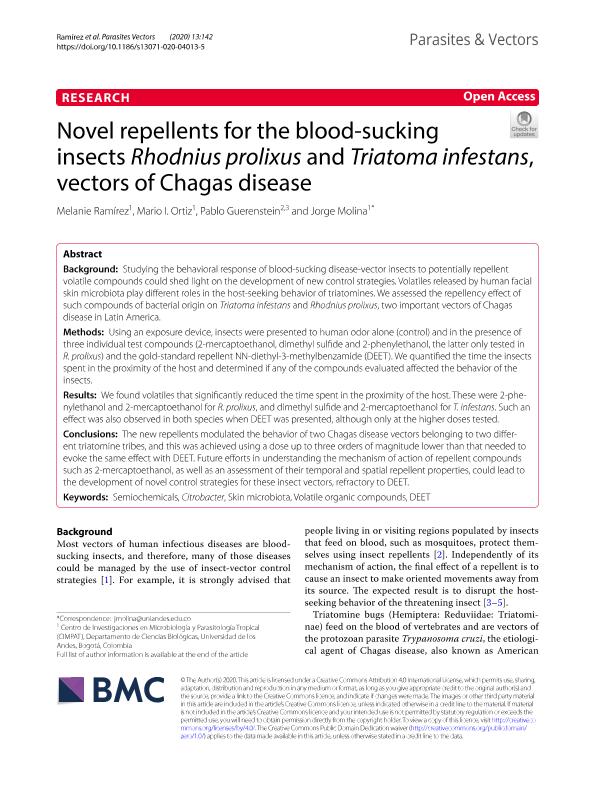Mostrar el registro sencillo del ítem
dc.contributor.author
Ramírez, Melanie
dc.contributor.author
Ortiz, Mario I.
dc.contributor.author
Guerenstein, Pablo Gustavo

dc.contributor.author
Molina, Jorge Luis

dc.date.available
2021-09-30T05:46:54Z
dc.date.issued
2020-03
dc.identifier.citation
Ramírez, Melanie; Ortiz, Mario I.; Guerenstein, Pablo Gustavo; Molina, Jorge Luis; Novel repellents for the blood-sucking insects Rhodnius prolixus and Triatoma infestans, vectors of Chagas disease; BioMed Central; Parasites and Vectors; 13; 1; 3-2020; 1-9
dc.identifier.issn
1756-3305
dc.identifier.uri
http://hdl.handle.net/11336/142002
dc.description.abstract
Background: Studying the behavioral response of blood-sucking disease-vector insects to potentially repellent volatile compounds could shed light on the development of new control strategies. Volatiles released by human facial skin microbiota play different roles in the host-seeking behavior of triatomines. We assessed the repellency effect of such compounds of bacterial origin on Triatoma infestans and Rhodnius prolixus, two important vectors of Chagas disease in Latin America. Methods: Using an exposure device, insects were presented to human odor alone (control) and in the presence of three individual test compounds (2-mercaptoethanol, dimethyl sulfide and 2-phenylethanol, the latter only tested in R. prolixus) and the gold-standard repellent NN-diethyl-3-methylbenzamide (DEET). We quantified the time the insects spent in the proximity of the host and determined if any of the compounds evaluated affected the behavior of the insects. Results: We found volatiles that significantly reduced the time spent in the proximity of the host. These were 2-phenylethanol and 2-mercaptoethanol for R. prolixus, and dimethyl sulfide and 2-mercaptoethanol for T. infestans. Such an effect was also observed in both species when DEET was presented, although only at the higher doses tested. Conclusions: The new repellents modulated the behavior of two Chagas disease vectors belonging to two different triatomine tribes, and this was achieved using a dose up to three orders of magnitude lower than that needed to evoke the same effect with DEET. Future efforts in understanding the mechanism of action of repellent compounds such as 2-mercaptoethanol, as well as an assessment of their temporal and spatial repellent properties, could lead to the development of novel control strategies for these insect vectors, refractory to DEET.
dc.format
application/pdf
dc.language.iso
eng
dc.publisher
BioMed Central

dc.rights
info:eu-repo/semantics/openAccess
dc.rights.uri
https://creativecommons.org/licenses/by-nc-sa/2.5/ar/
dc.subject
CITROBACTER
dc.subject
DEET
dc.subject
SEMIOCHEMICALS
dc.subject
SKIN MICROBIOTA
dc.subject
VOLATILE ORGANIC COMPOUNDS
dc.subject.classification
Zoología, Ornitología, Entomología, Etología

dc.subject.classification
Ciencias Biológicas

dc.subject.classification
CIENCIAS NATURALES Y EXACTAS

dc.title
Novel repellents for the blood-sucking insects Rhodnius prolixus and Triatoma infestans, vectors of Chagas disease
dc.type
info:eu-repo/semantics/article
dc.type
info:ar-repo/semantics/artículo
dc.type
info:eu-repo/semantics/publishedVersion
dc.date.updated
2021-09-07T14:11:13Z
dc.journal.volume
13
dc.journal.number
1
dc.journal.pagination
1-9
dc.journal.pais
Reino Unido

dc.journal.ciudad
Londres
dc.description.fil
Fil: Ramírez, Melanie. Universidad de los Andes; Colombia
dc.description.fil
Fil: Ortiz, Mario I.. Universidad de los Andes; Colombia
dc.description.fil
Fil: Guerenstein, Pablo Gustavo. Provincia de Entre Ríos. Centro de Investigaciones Científicas y Transferencia de Tecnología a la Producción. Universidad Autónoma de Entre Ríos. Centro de Investigaciones Científicas y Transferencia de Tecnología a la Producción. Consejo Nacional de Investigaciones Científicas y Técnicas. Centro Científico Tecnológico Conicet - Santa Fe. Centro de Investigaciones Científicas y Transferencia de Tecnología a la Producción; Argentina
dc.description.fil
Fil: Molina, Jorge Luis. Universidad de los Andes; Colombia
dc.journal.title
Parasites and Vectors

dc.relation.alternativeid
info:eu-repo/semantics/altIdentifier/url/https://parasitesandvectors.biomedcentral.com/articles/10.1186/s13071-020-04013-5
dc.relation.alternativeid
info:eu-repo/semantics/altIdentifier/doi/http://dx.doi.org/10.1186/s13071-020-04013-5
Archivos asociados
